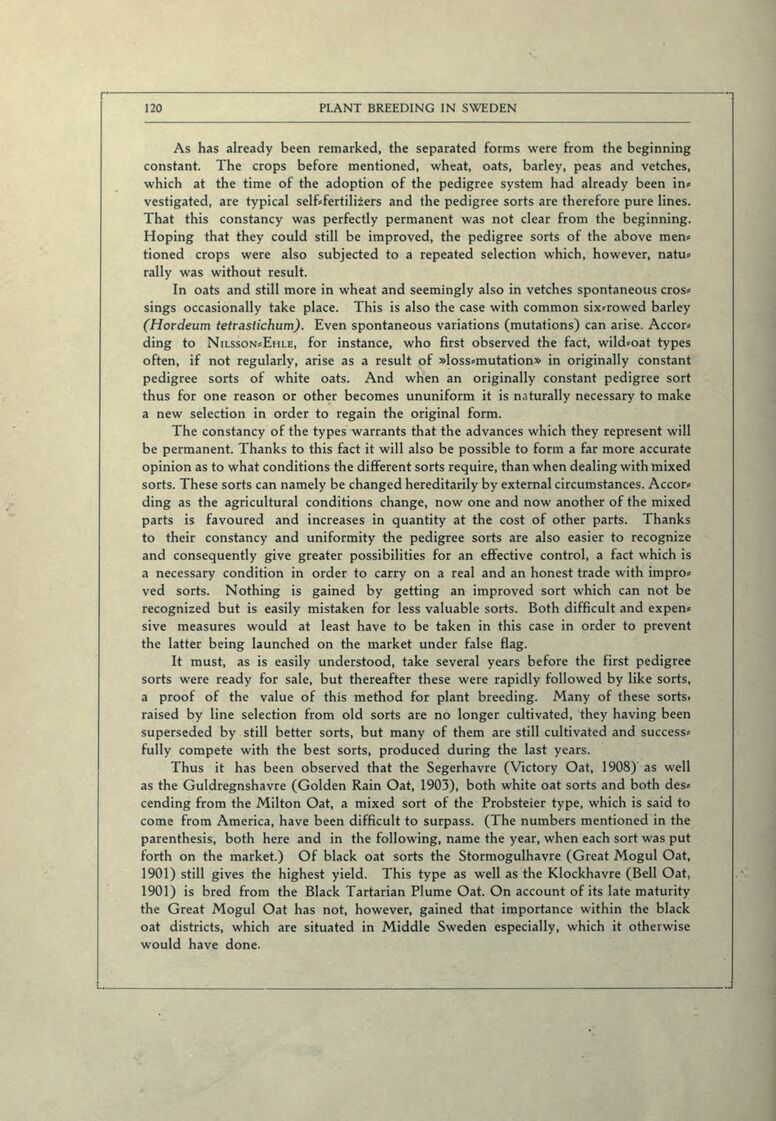
Full resolution (JPEG) - On this page / på denna sida - Part I - Doctor Hans Tedin, Svalöf, Plant Breeding in Sweden

<< prev. page << föreg. sida << >> nästa sida >> next page >>
Below is the raw OCR text
from the above scanned image.
Do you see an error? Proofread the page now!
Här nedan syns maskintolkade texten från faksimilbilden ovan.
Ser du något fel? Korrekturläs sidan nu!
This page has never been proofread. / Denna sida har aldrig korrekturlästs.
p––––––––––––––––––––––––––––––––––––––––––~J
120 PLANT BREEDING IN SWEDEN
As has already been remarked, the separated forms were from the beginning
constant. The crops before mentioned, wheat, oats, barley, peas and vetches,
which at the time of the adoption of the pedigree system had already been in*
vestigated, are typical self*fertilizers and the pedigree sorts are therefore pure lines.
That this constancy was perfectly permanent was not clear from the beginning.
Hoping that they could still be improved, the pedigree sorts of the above men*
tioned crops were also subjected to a repeated selection which, however, natu*
rally was without result.
In oats and still more in wheat and seemingly also in vetches spontaneous eros*
sings occasionally take place. This is also the case with common six*rowed barley
(Hordeum tetrasiichum). Even spontaneous variations (mutations) can arise. Accor*
ding to Nilsson*Ehle, for instance, who first observed the faet, wild*oat types
often, if not regularly, arise as a result of »loss*mutation» in originally constant
pedigree sorts of white oats. And when an originally constant pedigree sort
thus for one reason or other becomes ununiform it is naturally necessary to make
a new selection in order to regain the original form.
The constancy of the types warrants that the advances which they represent will
be permanent. Thanks to this faet it will also be possible to form a far more accurate
opinion as to what conditions the different sorts require, than when dealing with mixed
sorts. These sorts can namely be changed hereditarily by external circumstances. Accor*
ding as the agricultural conditions change, now one and now another of the mixed
parts is favoured and inereases in quantity at the cost of other parts. Thanks
to their constancy and uniformity the pedigree sorts are also easier to recognize
and consequently give greater possibilities for an effeetive control, a faet which is
a necessary condition in order to carry on a real and an honest trade with impro*
ved sorts. Nothing is gained by getting an improved sort which can not be
recognized but is easily mistaken for less valuable sorts. Both difficult and expen*
sive measures would at least have to be taken in this case in order to prevent
the latter being launched on the market under false flag.
It must, as is easily understood, take several years before the first pedigree
sorts were ready for sale, but thereafter these were rapidly followed by like sorts,
a proof of the value of this method for plant breeding. Many of these sorts,
raised by line selection from old sorts are no longer cultivated, they having been
superseded by still better sorts, but many of them are still cultivated and success*
fully compete with the best sorts, produced during the last years.
Thus it has been observed that the Segerhavre (Victory Oat, 1908) as well
as the Guldregnshavre (Golden Rain Oat, 1903), both white oat sorts and both des*
cending from the Milton Oat, a mixed sort of the Probsteier type, which is said to
come from America, have been difficult to surpass. (The numbers mentioned in the
parenthesis, both here and in the following, name the year, when each sort was put
forth on the market.) Of black oat sorts the Stormogulhavre (Great Mogul Oat,
1901) still gives the highest yield. This type as well as the Klockhavre (Bell Oat,
1901) is bred from the Black Tartarian Plume Oat. On account of its late maturity
the Great Mogul Oat has not, however, gained that importance within the black
oat districts, which are situated in Middle Sweden especially, which it otherwise
would have done.
<< prev. page << föreg. sida << >> nästa sida >> next page >>